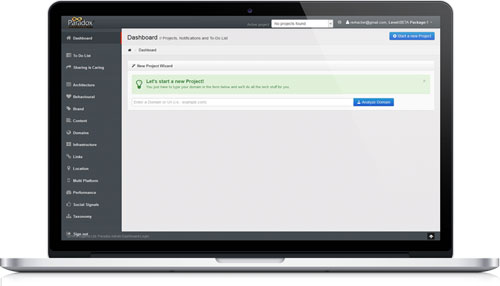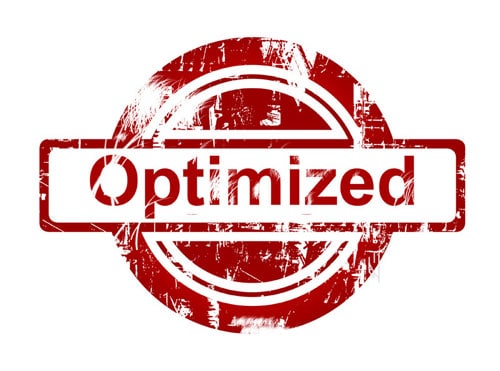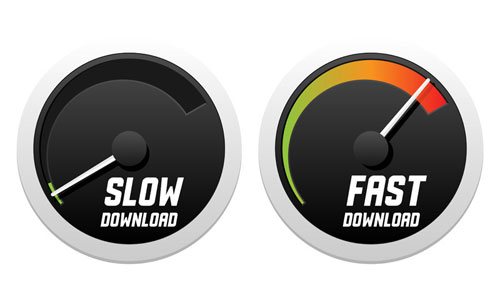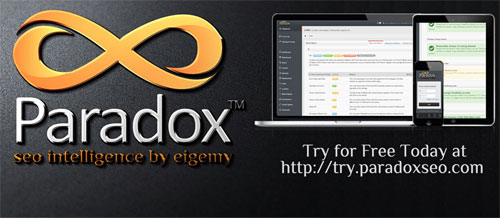The other day I had a chance to check out a brand new SEO tool called Paradox SEO. I should say it’s a really interesting new player on the block. It has tons of metrics and suggestions for your site, but I’d like to highlight only those that really kick butt.
Getting Started
Before going any further, you need to login to the backend of the Paradox SEO platform so that you can see what I’m talking about. You can login with your G+ or LinkedIn account. Alternatively, you can create a stand-alone account specifically for Paradox SEO.
Once you’re logged in, you should click the Start a New Project button and add your site address (URL) in the New Project Wizard text field. That done, you can just click the blue Analyze Domain button.

Now you just need to wait for a while so that the tool can collect and analyze all your site data it needs. It’ll just take a few seconds.
Interface
At this point, you should see three panes. The top one is Tip of the Day. You can use it to learn all sorts of tips and tricks that improve your site’s SEO. The second pane is called Notifications and it’s on the left-hand side. That’s where Paradox SEO notifies you about everything you need to know.
And finally you should see the To Do List pane on the right-hand side. That’s the most crucial pane because it lists all your site’s burning issues that you need to address first thing in the morning, so to put it. In order to see all your issues you need to take care of, you should click the View all todo list link under the list.
Epic Features
Now that you got a rough idea on how to actually add your site to the Paradox SEO tool, you may want to know what really sets the software aside compared to other players in the SEO software field.
Onsite Anchor Text Diversity
You can find the metric in the Architecture section of the tool. The Onsite Anchor Text Diversity metric checks how well you (your site) do in terms of varying anchor texts to your target page. In other words, if you use exactly the same keyword in all your anchor texts, that’s a pretty bad sign because it does not look (and is not) natural at all.
As a rule of thumb, you need to diversify your anchor texts by using partial match, SEO synonyms or just random words like (here, this link, read more, etc). Also, you should leverage the same approach in building your external links. That especially holds true if your link profile is overwhelmed with exact match anchor texts.
Use of Microformats
Though this metric is not a direct search engine optimization factor, it can still help you with driving traffic to your site because it allows you to use formatting to display data from your site right in your Google snippets. For example, if you own a pizza place and have a site for it, you may want to display ingredients, calories and cooking time right in your search snippet.
Site Depth
This is the number of page levels from the home page that the Paradox SEO tool had spidered before it ceased finding fresh links. Generally speaking, a good information architecture will result in between five and seven levels. The more crucial stuff (something you want your visitors to see foremost) should be on the higher levels.

Percentage of Brand Visits
It’s a metric that allows for understanding how many people search by your brand name. That’s a very good signal if the percentage is high because you most likely rank #1 for your brand name and you don’t have that much of a viable competition in that case. The best way to achieve that situation is by creating awesome content and promoting it both online and offline.
Percentage of Visits on Desktop (Tablets, Smartphones)
As you probably know, the amount of people who surf the web with their mobile devices is growing unapologetically fast. Other than using a responsive design, you may need to go even further and start using adaptive design which means taking into account not just the size of the screen but also the make or the phone and its peculiar features (iPhone, Nexus, etc). That’s why you want to keep track of what kind of devices are used for viewing your site.
Brand Citations Found
It goes without saying that you need to build actual clickable links that point back to your site, but you also need mere brand citations for your site. A brand citation is just a plain text mention of your site. That means you don’t have to be too on the edge if a site owner does not want to change your site (brand) mention into an actual clickable link. Luckily, the Paradox SEO software allows you to keep track of such mentions.
Link Signal to Citation Noise Ratio
This metric is a pretty theoretical factor that search engines might be using for gauging how natural your link profile is. The idea is that if your site is a decent one, you don’t just have clickable links to it, but also lots of mentions (citations). The higher the ratio between clickable links and plain text mentions (citation noise), the better it is for your site because it looks like a decent and authoritative site in that case.
Semantic Richness
Semantic richness refers to the amount of semantic information associated with a concept. This includes plurals, adjectives, but most importantly other terms that co-exist with the target terms in Google’s vast data set of documents. The idea derives from the phenomenon that certain terms (words) tend to appear with specific terms in texts across the web.
For example, if you compose a post about PHP, chances are, you’re going to use words like database, function, mysql, deploy, server, etc. Google knows which words tend to appear next to each other or in the same context. That’s exactly what this SEO metric goes to show in the tool.
Keyword Proximity
This metric gauges how close your keywords are to each other. Long story short, you just don’t want to use your keywords too often because it will be so 1995 to say the least of it. You want to use your keywords sparingly. The best way to do it is to actually zero in on the quality content your article is about rather than keyword proximity itself.
Coleman Liau Index and Automated Readability Index (ARI)
Since you don’t just want to create a huge piece of content, but you also want it to be readable by people, it’s a good idea to use the readability metrics provided by Paradox SEO. In a nutshell, The metric gauges the understandability of a text. The ideal value approximates the U.S. grade level thought necessary to comprehend the text.
Days to Expiry Date (of Your Domain)
It’s a really interesting feature and if you think about it for a second, you’ll see why it makes perfect sense. That’s what happened to me at least. If you paid and registered your domain for 5-10 years in advance, odds are, you’re a serious site owner who is not going to run an indecent site. Chances are, Google is using the same logic in this regard. So you should check your domain expiry date tomorrow morning.
CDN Detection
Another really useful feature to keep an eye on is CDN detection because it shows if your site uses a content delivery network. In case you create content for different countries or just locations across the globe, it really makes sense to use a CDN because your site will load faster and always be up because if one server goes down, the others are still up at all times.

Responsive Design Detected
The Paradox SEO tool makes it possible to make sure that you’re in the know if the site you work on uses responsive design or not. Once you’ve added your site to the tool, you’re not supposed to do anything extra, the software will automatically detect if your site uses responsive design which is both an SEO and usability benefit.
Avg. Age of Links in Days
The Avg. Age of Links in Days metric makes perfect sense as well because if your site has “old” links, it means it’s an established and reliable resource rather than just something aimed to get money and get lost before you know it. With that in mind, you want to steadily built links that stay there for good or at least for a really long time (a year or more).
Apple Touch Icon
The icon is just an image that represents your site once bookmarked on an iOS device. This is not an SEO thing per se (as far as I know) , but it definitely sets your site aside because not that many sites go the extra mile to add an Apple touch icon. It’s a great chance to stand out from the crown with just a few extra moves.
Alexa Average Load Time
It’s another factor that you need to keep in mind while optimizing your site speed. As a rule of thumb, you want to use a few tools to test how fast your site loads so that your result is as precise as possible. You should use a few tools while doing that sort of researches because each tool works a bit differently and you need the most precise result possible.

Image, CSS & JS Calls
In this particular case, calls are the amount of times your page contacts external pages or sites in order to work properly (as expected by the developer). You need to keep your image, CSS and JavaScript calls to a minimum because it will make your site faster. The easiest way to do that is to optimize the amount and quality of images, plus make CSS and JS files load from one file respectively.
Blog Citations Found and News Citations
And the last metric that I’d like to point out here is citations. You want your site to be mentioned (just a brand name without being a clickable link) both in reputable blogs and news sites because (like I said above) having mentions alongside with links pointing to your site is a really positive signal when it comes to SEO and Google in particular.
Bottom Line
The Paradox SEO software allows you to take into account some important SEO metrics which other alternative tools just don’t give you data about. That’s exactly what makes the tool an irreplaceable one when it comes to professional search engine optimization in our day and age.
Did you have a chance to use the tool? What are your overall impressions?





